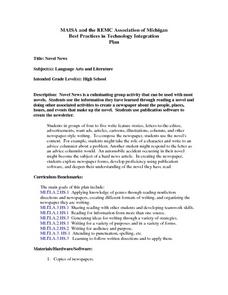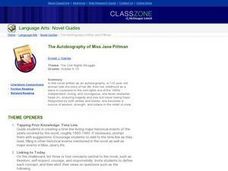PBS
Their Eyes Were Watching God: The Impact of Language
Author, filmmaker, and anthropologist Zora Neale Hurston was also a dialectologist. The dialogue of the characters in her novel Their Eyes Were Watching God reveals her fascination with accents and dialects. A short video from the Great...
PBS
Their Eyes Were Watching God: Socratic Seminar
A Socratic seminar wraps-up a study of Zora Neale Hurston' Their Eyes were Watching God. Using the text and their notes, scholars focus on how characters in the novel accept or reject the societal norms of the times.
PBS
Symbolism and the Use of “New Language” in The Handmaid’s Tale
Words matter. Words frame thought. Words are symbolic. Readers of Margaret Atwood's The Handmaid's Tale examine how the words In Gilead's "New Language" reinforce the power of the government and provided insight into the symbolic level...
EngageNY
End of Unit Assessment: Finding Evidence of Laurence Yep’s Perspective on Being Chinese in Dragonwings and Determining Connotative Language
There's a fine line between reality and fiction. As an end-of-unit assessment, scholars complete worksheets to analyze how Laurence Yep's perspective on being Chinese factors into his novel Dragonwings. Next, pupils engage in a...
National Endowment for the Humanities
Literary Genres in “Moby-Dick”
Moby Dick is more than a whale of a tale narrated by Ishmael. A lesson studying Herman Melville's classic novel asks readers to examine the different genres the author weaves into his story. Instructors model how to conduct a stylistic...
National Endowment for the Humanities
Dostoevsky's Crime and Punishment
Pain and suffering do not have to be inevitable in a study of Crime and Punishment. A carefully scaffolded lesson introduces readers to the divided natures of the characters in Fyodor Dostoevsky's complex novel. Groups use the...
National Endowment for the Humanities
Magical Elements in Magical Realism
How does Gabriel Garcia Marquez make the magical elements of his novel appear so real? That's the challenge facing readers of One Hundred Years of Solitude. Scholars examine the tone and descriptive details Garcia Marquez uses to...
K20 LEARN
Lord of the Flies Unit, Lesson 4: Bad to the Bone
Is the nature of humans inherently good or evil? That is the question scholars consider in the fourth lesson of the Lord of the Flies unit. In a Four Corners activity, they examine statements about human nature and stand by the poster...
K20 LEARN
The Eyes of Dr. T. J. Eckleburg: The Great Gatsby and the Sense of Sight
To conclude a study of The Great Gatsby, class members create a multimodal project that represents what they feel the eyes of Dr. T.J. Eckleburg see about the hidden side of one of the characters in F. Scott Fitzgerald's classic...
K20 LEARN
Sentence Structure in Siddhartha: Simple, Compound, Complex, and Compound-Complex Sentences
While wisdom may not be communicated, knowledge of sentence structures certainly can. Teach young grammarians the power of syntax with a lesson that uses Herman Hesse's Siddhartha as a mentor text. Learners first rewrite captions for an...
Curated OER
Comprehension
Fifth graders study comprehension. In this writing lesson plan, 5th graders remember what they read and write an introduction for a character from a novel just read including a good description of that character.
Curated OER
Lesson Plan on Korea
Students read a variety of novels and watch clips of films through which they begin to feel empathy for cultures and countries occupied by foreign countries. They have the option of studying the Sino-Japanese Wars or the Russo-Japanese...
Curated OER
Out of the Dust: Narrative Essay
To conclude their study of Out of the Dust, the 1998 Newbery Medal winning verse novel, individuals craft a narrative essay based on one of the themes in Karen Hesse's novel.
Curated OER
Maus: Cubing Questioning Strategy
Maus is the text for a postreading activity that has class members using a cubing strategy to analyze, in depth, topics (racism, past and present, forgetting/remembering the Holocaust, representing the Holocaust) associated with Art...
Brigham Young University
Out of the Dust: Cubing Strategy
Imagine using a six-sided cube to encourage readers to analyze a topic in greater depth. Create a cube, label each of the six sides with one of Bloom's comprehension levels, and you're ready to launch a discussion of a text....
Curated OER
Lesson Plan 3: Great Book, Gross Book
It's time for your scholars to become book reviewers! Start with a fun review of foods: are they good or gross? Learners apply these evaluation techniques to books, recording their thoughts on large pieces of butcher paper. Simply have...
Curated OER
The Lion, the Witch, and the Wardrobe: Vocab Squares
Creatively develop and reinforce new vocabulary from the book, The Lion, the Witch, and the Wardrobe by C.S. Lewis, using these vocabulary squares. Each square is divided into four quadrants asking scholars to input the word, a...
Curated OER
The Lion, the Witch, and the Wardrobe: Anticipation Guide
Before reading The Lion, the Witch, and the Wardrobe by C.S. Lewis, take part in this thought-provoking, pre-reading activity that invites discussion about the story's theme using universal adages.
Curated OER
NOVEL PARTNERS
Students read novels, completing a weekly assignment as they read. They meet weekly with another student to discuss the readings and assignments.
Curated OER
Culminating Activities for Sharon Draper’s Novel Copper Sun
Student examine the elements of literature. In this literature lesson, young scholars follow the provided procedures to review the novel Copper Sun by Sharon Draper.
Curated OER
Novel News
Students, working in groups create a newspaper based on the events that take place in a novel. Groups complete sections of the newsletter based on criteria and publish it using newsletter publishing software.
Curated OER
The Autobiography of Miss Jane Pittman: Novel Guides
Learners create a timeline listing major historical events of the years 1860-1960. They discuss concepts central to the novel, such as freedom, self-respect, courage, and responsibility.
Curated OER
Number the Stars: My Response to the Novel
In this reading response worksheet, young scholars write their feelings about the novel Number the Stars by Lois Lowry. Students complete separate paragraphs which begin " I wish, I wonder, I hope, I believe, I am thankful that..."
Curated OER
Catalog Display for the Novel : The Family Under the Bridge by Natalie Carlson
Fourth graders explain the novel through creative descriptions, learn importance of word choice in descriptive writing, and implement technology skills of searching the Internet, typing, cutting and pasting, graphic designs, and...

























